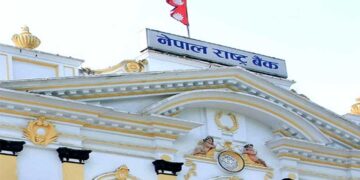Nepal’s economy grew by 4.61 percent in the fiscal year (FY) 2081/82, with the total size of the economy reaching Rs 61 trillion 7 billion 22 crore, according to the annual report published by the Ministry of Finance today.
The report shows that out of the total budget allocation of Rs 18 trillion 60 billion 30 crore, the government spent Rs 15 trillion 12 billion 98 crore, which accounts for 81.33 percent of the total budget.
Under the current expenditure, Rs 11 trillion 40 billion 67 crore was allocated, of which Rs 9 trillion 56 billion 36 crore—or 83.84 percent—was spent.
For capital expenditure, Rs 3 trillion 52 billion 35 crore was allocated, while the spending reached Rs 2 trillion 23 billion 94 crore, or 63.56 percent. Similarly, under financial management, Rs 3 trillion 67 billion 28 crore was allocated, of which Rs 3 trillion 32 billion 67 crore—or 90.58 percent—was utilized.
In the fiscal year, the total revenue collection stood at Rs 11 trillion 96 billion 18 crore 98 lakh. Of this, tax revenue accounted for Rs 10 trillion 49 billion 87 crore 54 lakh, non-tax revenue was Rs 1 trillion 28 billion 94 crore 48 lakh, and other receipts totaled Rs 17 billion 36 crore 96 lakh, according to the ministry.
Compared to the revenue target of Rs 14 trillion 19 billion 30 crore 30 lakh, the government achieved 84.28 percent of its target.
Nepal also received a total of Rs 1 trillion 48 billion 93 crore in foreign assistance during FY 2081/82—comprising Rs 23 billion 53 crore in grants and Rs 1 trillion 25 billion 40 crore in loans. Grants made up 15.80 percent, while loans accounted for 84.20 percent of the total foreign aid.
To finance the budget deficit, the government mobilized a total of Rs 4 trillion 55 billion 39 crore in public debt, which included Rs 3 trillion 29 billion 99 crore in domestic borrowing and Rs 1 trillion 25 billion 40 crore in external loans.









